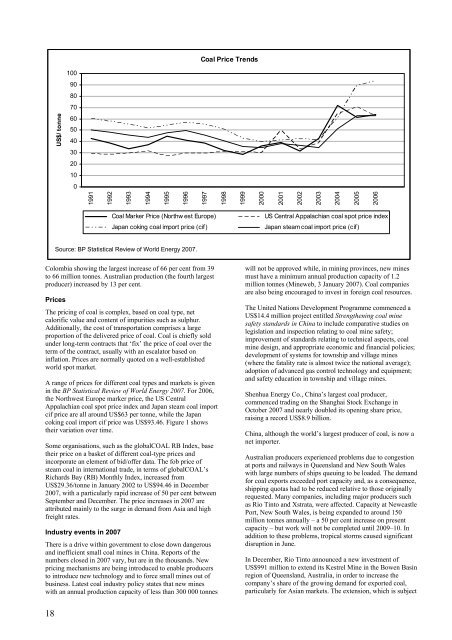World Mineral Production - NERC Open Research Archive - Natural ...
World Mineral Production - NERC Open Research Archive - Natural ...
World Mineral Production - NERC Open Research Archive - Natural ...
Create successful ePaper yourself
Turn your PDF publications into a flip-book with our unique Google optimized e-Paper software.
Colombia showing the largest increase of 66 per cent from 39<br />
to 66 million tonnes. Australian production (the fourth largest<br />
producer) increased by 13 per cent.<br />
Prices<br />
The pricing of coal is complex, based on coal type, net<br />
calorific value and content of impurities such as sulphur.<br />
Additionally, the cost of transportation comprises a large<br />
proportion of the delivered price of coal. Coal is chiefly sold<br />
under long-term contracts that ‘fix’ the price of coal over the<br />
term of the contract, usually with an escalator based on<br />
inflation. Prices are normally quoted on a well-established<br />
world spot market.<br />
A range of prices for different coal types and markets is given<br />
in the BP Statistical Review of <strong>World</strong> Energy 2007. For 2006,<br />
the Northwest Europe marker price, the US Central<br />
Appalachian coal spot price index and Japan steam coal import<br />
cif price are all around US$63 per tonne, while the Japan<br />
coking coal import cif price was US$93.46. Figure 1 shows<br />
their variation over time.<br />
Some organisations, such as the globalCOAL RB Index, base<br />
their price on a basket of different coal-type prices and<br />
incorporate an element of bid/offer data. The fob price of<br />
steam coal in international trade, in terms of globalCOAL’s<br />
Richards Bay (RB) Monthly Index, increased from<br />
US$29.36/tonne in January 2002 to US$94.46 in December<br />
2007, with a particularly rapid increase of 50 per cent between<br />
September and December. The price increases in 2007 are<br />
attributed mainly to the surge in demand from Asia and high<br />
freight rates.<br />
Industry events in 2007<br />
There is a drive within government to close down dangerous<br />
and inefficient small coal mines in China. Reports of the<br />
numbers closed in 2007 vary, but are in the thousands. New<br />
pricing mechanisms are being introduced to enable producers<br />
to introduce new technology and to force small mines out of<br />
business. Latest coal industry policy states that new mines<br />
with an annual production capacity of less than 300 000 tonnes<br />
18<br />
US$/ tonne<br />
100<br />
90<br />
80<br />
70<br />
60<br />
50<br />
40<br />
30<br />
20<br />
10<br />
0<br />
1991<br />
1992<br />
1993<br />
1994<br />
1995<br />
1996<br />
Coal Price Trends<br />
1997<br />
1998<br />
1999<br />
Coal Marker Price (Northw est Europe) US Central Appalachian coal spot price index<br />
Japan coking coal import price (cif) Japan steam coal import price (cif)<br />
Source: BP Statistical Review of <strong>World</strong> Energy 2007.<br />
2000<br />
2001<br />
2002<br />
2003<br />
2004<br />
2005<br />
2006<br />
will not be approved while, in mining provinces, new mines<br />
must have a minimum annual production capacity of 1.2<br />
million tonnes (Mineweb, 3 January 2007). Coal companies<br />
are also being encouraged to invest in foreign coal resources.<br />
The United Nations Development Programme commenced a<br />
US$14.4 million project entitled Strengthening coal mine<br />
safety standards in China to include comparative studies on<br />
legislation and inspection relating to coal mine safety;<br />
improvement of standards relating to technical aspects, coal<br />
mine design, and appropriate economic and financial policies;<br />
development of systems for township and village mines<br />
(where the fatality rate is almost twice the national average);<br />
adoption of advanced gas control technology and equipment;<br />
and safety education in township and village mines.<br />
Shenhua Energy Co., China’s largest coal producer,<br />
commenced trading on the Shanghai Stock Exchange in<br />
October 2007 and nearly doubled its opening share price,<br />
raising a record US$8.9 billion.<br />
China, although the world’s largest producer of coal, is now a<br />
net importer.<br />
Australian producers experienced problems due to congestion<br />
at ports and railways in Queensland and New South Wales<br />
with large numbers of ships queuing to be loaded. The demand<br />
for coal exports exceeded port capacity and, as a consequence,<br />
shipping quotas had to be reduced relative to those originally<br />
requested. Many companies, including major producers such<br />
as Rio Tinto and Xstrata, were affected. Capacity at Newcastle<br />
Port, New South Wales, is being expanded to around 150<br />
million tonnes annually – a 50 per cent increase on present<br />
capacity – but work will not be completed until 2009–10. In<br />
addition to these problems, tropical storms caused significant<br />
disruption in June.<br />
In December, Rio Tinto announced a new investment of<br />
US$991 million to extend its Kestrel Mine in the Bowen Basin<br />
region of Queensland, Australia, in order to increase the<br />
company’s share of the growing demand for exported coal,<br />
particularly for Asian markets. The extension, which is subject

















